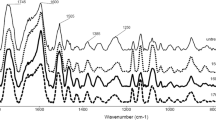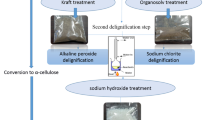Abstract
Delignified fibres from E. benthamii, E. nitens and E. smithii were treated with different NaOH concentrations (up to 30%, w/v) at two different temperatures (25 °C and 80 °C) to investigate the polymorphic and morphological variations in cellulose. The results showed that de-crystallization and the polymorphic transformation of cellulose started at 10% (w/v) NaOH. At 10% (w/v) NaOH, the cellulose II content was similar among the samples from the different species, but changes were observed in the cellulose I content and amorphous fraction. Alkalization at 25 °C had a higher de-crystallization effect than that at 80 °C. E. benthamii showed the highest cristallinity index values and E. nitens the lowest. The crystallite size of cellulose I (L(200)) increased as the NaOH concentration increased, while the temperature seemed to not have a significant influence on the L(200) variation. E. benthamii showed the highest L(200) (3.5–5.0 nm) while E. nitens showed the lowest (3.3–4.5 nm). The crystallite size of cellulose II (L(020)) was higher (4.8–5.2 nm) than that of cellulose I L(200) (3.3–5.0 nm). Alkalization at a higher temperature resulted in a higher cellulose II L(020). Morphologically, at a 0.5% NaOH concentration, the fibres were embedded in a gel-like substance, and, with the NaOH concentration above 10%, the fibres were converted into a swollen and roughened state. Thus, different Eucalyptus species at given NaOH concentrations displayed different structural features, which could lead to procedures and products with different requirements towards the manufacturing of cellulose derivatives.
Graphical Abstract







Similar content being viewed by others
References
Agarwal UP, Ralph SA, Reiner RS, Baez C (2016) Probing crystallinity of never-dried wood cellulose with Raman spectroscopy. Cellulose 23:125–144
Agarwal UP, Ralph SA, Baez C, Reiner RS, Verrill SP (2017) Effect of sample moisture content on XRD-estimated cellulose crystallinity index and crystallite size. Cellulose 24:1971–1984
Ahvenainen P, Kontro I, Svedström K (2016) Comparison of sample crystallinity determination methods by X-ray diffraction for challenging cellulose I materials. Cellulose 23:1073–1086
Arnoul-Jarriault B, Lachenal D, Chirat C, Heux L (2015) Upgrading softwood bleached kraft pulp to dissolving pulp by cold caustic treatment and acid-hot caustic treatment. Ind Crops Prod 65:565–571
Barneto AG, Hernández RB, Berenguer JM (2011) Thermogravimetric characterization of Eucalyptus wood. O Pap. 72:53–56
Borysiak S, Doczekalska B (2005) X-ray diffraction study of Pine wood treated with NaOH. Fibres Text East Eur 13:87–89
Borysiak S, Garbarczyk J (2003) Applying the WAXS method to estimate the supramolecular structure of cellulose fibres after mercerization. Fibres Text East Eur 11:104–106
Carrillo I, Mendonça RT, Ago M, Rojas OJ (2018) Comparative study of cellulosic components isolated from different Eucalyptus species. Cellulose 25:1011–1029
Chandrasekar M, Ishak MR, Sapuan SM, Leman Z, Jawaid M (2017) A review on the characterisation of natural fibres and their composites after alkali treatment and water absorption. Plast Rubber Compost 46:119–136
Dinand E, Vignon M, Chanzy H, Heux L (2002) Mercerization of primary wall cellulose and its implication for the conversion of cellulose I → cellulose II. Cellulose 9:7–18
Duchemin BJC (2015) Mercerisation of cellulose in aqueous NaOH at low concentrations. Green Chem 17:3941–3947
Duchemin B, Thuault A, Vicente A, Rigaud B, Fernandez C, Eve S (2012) Ultrastructure of cellulose crystallites in flax textile fibres. Cellulose 19:1837–1854
Ek M, Gellerstedt G, Henriksson G (2009) Pulp and paper chemistry and technology. Wood chemistry and wood biotechnology, vol 1. GmbH & Co.KG, Berlin
El Oudiani A, Chaabouni Y, Msahli S, Sakli F (2011) Crystal transition from cellulose I to cellulose II in NaOH treated Agave americana L. fibre. Carbohydr Polym 86:1221–1229
El Oudiani A, Caabouni Y, Msahli S, Sakli F (2012) Mercerization of Agave americana L. fibers. J Text I 103:565–574
Fengel D, Strobel C (1994) FTIR spectroscopic studies on the heterogeneous transformation of cellulose I into cellulose I. Acta Polym 45:319–324
Fink HP, Hoffmann D, Philipp B (1995) Some aspects of lateral chain order in cellulosics from X-ray scattering. Cellulose 2:51–70
French AD (2014) Idealized powder diffraction patterns for cellulose polymorphs. Cellulose 21:885–896
Gardner KH, Blackwell J (1974) The structure of native cellulose. Biopolymers 13:1975–2001
Gehmayr V, Sixta H (2012) Pulp properties and their influence on enzymatic degradability. Biomacromol 13:645–651
Gehmayr V, Schild G, Sixta H (2011) A precise study on the feasibility of enzyme treatments of a kraft pulp for viscose application. Cellulose 18:479–491
Isogai A, Atalla RH (1998) Dissolution of cellulose in aqueous NaOH solutions. Cellulose 5:309–319
Jiao C, Xiong J (2014) Accessibility and morphology of cellulose fibres treated with sodium hydroxide. BioResources 9:6504–6513
Jin E, Guo J, Yang F, Zhu Y, Song J, Jin Y, Rojas OJ (2016) On the polymorphic and morphological changes of cellulose nanocrystals (CNC-I) upon mercerization and conversion to CNC-II. Carbohydr Polym 143:327–335
Kreze T, Malej S (2003) Structural characteristics of new and conventional regenerated cellulosic fibers. Text Res J 73:675–684
Kroon-Batenburg LMJ, Kroon J (1997) The crystal and molecular structures of cellulose I and II. Glycoconj J 14:677–690
Langan P, Nishiyama Y, Chanzy H (1999) A revised structure and hydrogen-bonding system in cellulose II from a neutron fiber diffraction analysis. J Am Chem Soc 121:9940–9946
Le Moigne N, Navard P (2010) Dissolution mechanisms of wood cellulose fibres in NaOH-water. Cellulose 17:31–45
Lee MH, Park HS, Yoon KJ, Hauser PJ (2004) Enhancing the durability of linen-like properties of low temperature mercerized cotton. Text Res J 74:146–154
Lee H, Sundaram J, Zhu L, Zhao Y, Mani S (2018) Improved thermal stability of cellulose nanofibrils using low-concentration alkaline pretreatment. Carbohydr Polym 181:506–513
Leppänen K, Andersson S, Torkkeli M, Knaapila M, Kotelnikova N, Serimaa R (2009) Structure of cellulose and microcrystalline cellulose from various wood species, cotton and flax studied by X-ray scattering. Cellulose 16:999–1015
Li H, Legere S, He Z, Zhang H, Li J, Yang B, Zhang S, Zhang L, Zheng L, Ni Y (2018) Methods to increase the reactivity of dissolving pulp in the viscose rayon production process: a review. Cellulose 25:3733–3753
Liu Y, Hu H (2008) X-ray diffraction study of bamboo fibers treated with NaOH. Fiber Polym 9:735–739
Mendonça RT, Jara J, González V, Elissetche J, Freer J (2008) Evaluation of the white-rot fungi Ganoderma austral and Ceriposipsis subvermispora in biotechnological applications. J Ind Microbiol Biotechnol 35:1323–1330
Mwaikambo LY, Ansell MP (2002) Chemical modification of hemp, sisal, jute and kapok fibers by alkalization. J App Polym Sci 84:2222–2234
Nagarajan S, Skillen NC, Irvine JTS, Lawton LA, Robertson PKJ (2017) Cellulose II as bioethanol feedstock and its advantages over native cellulose. Renew Sustain Energ Rev 77:182–192
Nakano T (2010) Mechanism of microfibril contraction and anisotropic dimensional changes for cells in wood treated with aqueous NaOH solution. Cellulose 17:711–719
Nakano S, Nakano T (2015) Morphological changes induced in wood samples by aqueous NaOH treatment and their effects on the conversion of cellulose I to cellulose II. Holzforschung 69:483–491
Nakano T, Sugiyama J, Norimoto M (2000) Contractive force and transformation of microfibril with aqueous sodium hydroxide solution for wood. Holzforschung 54:315–320
Nakano T, Tanimoto T, Hashimoto T (2013) Morphological change induced with NaOH-water solution for ramie fiber: change mechanism and effects of concentration and temperature. J Mater Sci 48:7510–7517
Nam S, French AD, Condon BD, Concha M (2016) Segal crystallinity index revisited by the simulation of X-ray diffraction patterns of cotton cellulose Ib and cellulose II. Carbohydr Polym 135:1–9
Newman RH (2004) Carbon-13 NMR evidence for cocrystallization of cellulose as a mechanism for hornification of bleached kraft pulp. Cellulose 11:45–52
Oh SY, Yoo DI, Shin Y, Kim HC, Kim HY, Chung YS, Park WH, Youk JH (2005) Crystalline structure analysis of cellulose treated with sodium hydroxide and carbon dioxide by means of X-ray diffraction and FTIR spectroscopy. Carbohydr Res 340:2376–2391
Okano T, Sarko A (1985) Mercerization of cellulose. II. Alkali-cellulose intermediate and a possible mercerization mechanism. J Appl Polym Sci 30:325–332
Park S, Baker JO, Himmel ME, Parilla PA, Johnson DK (2010) Cellulose crystallinity index: measurement techniques and their impact on interpreting cellulose performance. Biotechnol Biofuels 3:10
Poletto M, Ornaghi H, Zattera A (2014) Native cellulose: structure, characterization and thermal properties. Materials 7:6105–6119
Popescu CM, Popescu MC, Singurel G, Vasile C, Argyropoulos DS, Wilfor S (2007) Spectral characterization of Eucalyptus wood. Appl Spectrosc 61:1168–1177
Popescu CM, Singurel G, Popescu MC, Vasile C, Argyropoulos DS, Willfor S (2009) Vibrational spectroscopy and X-ray diffraction methods to establish the differences between hardwood and softwood. Carbohydr Polym 77:851–857
Porro F, Bédué I, Chanzy H, Heux L (2007) Solid-state 13C NMR study of Na-cellulose complexes. Biomacromol 8:2586–2593
Quintana E, Valls C, Vidal T, Roncero MB (2015) Comparative evaluation of the action of two different endoglucanases. Part I: on a fully bleached, commercial acid sulfite dissolving pulp. Cellulose 22:2067–2079
Reyes DCA, Gorzsás A, Stridh K, de Wit P, Sundman O (2017) Alkalization of dissolving pulp with highly concentrated caustic at low NaOH stoichiometric excess. Carbohydr Polym 165:213–220
Saito T, Kimura S, Nishiyama Y, Isogai A (2007) Cellulose nanofibers prepared by TEMPO-mediated oxidation of native cellulose. Biomacromol 8:2485–2491
Scherrer P (1918) Bestimmung der Grösse und der inneren Struktur von Kolloidteilchen mittels Röntgenstrahlen. Nachrichten von der Gesellschaft der Wissenschaften, Göttingen
Sears KD, Hinck JF, Sewell CG (1982) Highly reactive wood pulps for cellulose acetate production. J Appl Polym Sci 27:4599–4610
Sixta H (2006) Handbook of pulp. Wiley-Vch Verlag GmbH & Co. KGaA, Weinheim
Sugiyama J, Vuong R, Chanzy H (1991) Electron diffraction study on the two crystalline phases occurring in native cellulose from algal cell wall. Macromolecules 24:4168–4175
Tonoli GHD, Teixeira EM, Correa AC, Marconcini JM, Caixeta LA, Pereira-da-Silva MA, Mattoso LHC (2012) Cellulose micro/nanofibres from Eucalyptus kraft pulp: preparation and properties. Carbohydr Polym 89:80–88
Tonoli GHD, Holtman KM, Glenn G, Fonseca AS, Wood D, Williams T, Sa VA, Torres L, Klamczynski A, Orts WJ (2016) Properties of cellulose micro/nanofibers obtained from Eucalyptus pulp fiber treated with anaerobic digestate and high shear mixing. Cellulose 23:1239–1256
Wada M, Okano T, Sugiyama J (1997) Synchrotron-radiated X-ray and neutron diffraction study of native cellulose. Cellulose 4:221–232
Wada M, Okano T, Sugiyama J (2001) Allomorphs of native crystalline cellulose I evaluated by two equatorial d-spacings. J Wood Sci 47:124–128
Wada M, Ike M, Tokuyasu K (2010) Enzymatic hydrolysis of cellulose I is greatly accelerated via its conversion to the cellulose II hydrate form. Polym Degrad Stab 95:543–548
Xing L, Gu J, Zhang W, Tu D, Hu C (2018) Cellulose I and II nanocrystals produced by sulfuric acid hydrolysis of tetra pak cellulose I. Carbohydr Polym 192:184–192
Yokoyama T, Kadla KF, Chang HM (2002) Microanalytical method for the characterization of fiber components and morphology of woody plants. J Agric Food Chem 50:1040–1044
Yu L, Lin J, Tian F, Li X, Bian F, Wang J (2014) Cellulose nanofibrils generated from jute fibers with tunable polymorphs and crystallinity. J Mater Chem A 2:6402–6411
Yue Y, Zhou C, French AD, Xia G, Han G, Wang Q, Wu Q (2012) Comparative properties of cellulose nano-crystals from native and mercerized cotton fibers. Cellulose 19:1173–1187
Yue Y, Han G, Wu Q (2013) Transitional properties of cotton fibers from cellulose I to cellulose structure. BioResources 8:6460–6471
Acknowledgments
Financial support from FONDECYT (research Grant No. 1160306) and the provision of facilities and technical support by Instituto GEA-UdeC for XRD analysis and CESMI-UdeC for SEM analysis are acknowledged. ICV thanks CONICYT for a Ph.D. Grant (No. 21180299).
Author information
Authors and Affiliations
Corresponding author
Electronic supplementary material
Below is the link to the electronic supplementary material.
Rights and permissions
About this article
Cite this article
Carrillo-Varela, I., Pereira, M. & Mendonça, R.T. Determination of polymorphic changes in cellulose from Eucalyptus spp. fibres after alkalization. Cellulose 25, 6831–6845 (2018). https://doi.org/10.1007/s10570-018-2060-4
Received:
Accepted:
Published:
Issue Date:
DOI: https://doi.org/10.1007/s10570-018-2060-4




